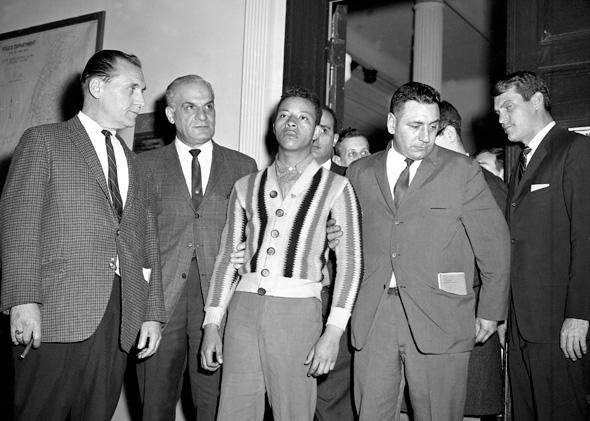Wednesday, Aug. 28, marks the 50th anniversary of the March on Washington, a hugely important event in the American civil rights movement. But a recent NPR story reminded me that it also marks the 50th anniversary of New York’s infamous “Career Girls Murders,” an all-but-forgotten crime that made clear why the March on Washington was so very necessary. An innocent young black man, George Whitmore Jr., was bullied by police into confessing to the murders and other crimes. By the end of his near-decade-long legal odyssey, his story had become a key component in the state of New York’s decision to abolish the death penalty, and had factored into the Supreme Court’s ruling in Miranda v. Arizona. And, more broadly, Whitmore’s saga made it plain to see just how easy it could be for racist, ambitious cops and prosecutors to railroad an innocent man.
The crime itself was brutal. In 1963 a home invader murdered two young Upper East Side women, 21-year-old Janice Wylie and 23-year-old Emily Hoffert. (Wylie and Hoffert had both come to New York to launch their careers, hence the “Career Girls” nickname.) The NYPD had no real leads until they arrested a black New Jersey teenager named George Whitmore on suspicion of raping a Brooklyn woman named Elba Borrero. When he was arrested, Whitmore had in his wallet a photograph of a white woman, who was soon (mistakenly) identified as Janice Wylie. Whitmore immediately became a suspect in the Wylie and Hoffert killings.
Though he had nothing to do with the murders—or, indeed, with the rape for which he was originally arrested—Whitmore was nevertheless coerced into confessing not only that he had killed Wylie and Hoffert, but that he had raped Borrero, and, for good measure, that he had killed a third woman named Minnie Edmonds. The police let it be known that the Career Girls Murders were solved.
They weren’t. The holes in Whitmore’s confession were almost immediately apparent. Witnesses placed Whitmore in New Jersey at the time of the murders, watching the March on Washington on television. The purportedly incriminating photo of Janice Wylie in Whitmore’s wallet was actually a photo of a high school classmate named Arlene Franco. He had never even been to the Upper East Side.
The Brooklyn-based detective who had led Whitmore’s questioning, Edward Bulger, was a violent bully. (As a Feb. 8, 1969, New Yorker piece on Whitmore’s arrest puts it, Manhattan police officers “were said to look with disdain on the Brooklyn detective’s rather blunt approach to the interrogation of suspects.”) Transcripts made clear that Bulger and his colleagues had obviously coached Whitmore on his confession. The New Yorker piece notes:
In some instances, the questions seem not only to lead the subject but actually to direct him to make specific answers. In the Borrero case, Whitmore is describing the attack itself:
Q.: What was she doing?
A.: She was putting up a struggle.
Q.: And where did you take her?
A.: Into a house.
Q.: Into a what?
A.: An alley.
Q.: An alley or basement?
A.: A basement.
Manhattan prosecutors soon realized they had the wrong man. But they didn’t tell Whitmore, and they didn’t immediately drop the charges. This was bad news for Whitmore, who was also facing charges in Brooklyn in the Borrero rape and the Edmonds murder, neither of which he actually committed. Whitmore was indeed found guilty of the Borrero rape, largely on account of his reputation as the violent Career Girls killer. Later, a juror in the Borrero case would admit that “practically everyone” on the jury knew about the Wylie-Hoffert charges. This was at the end of 1964.
1965 was a big year for Whitmore. In January a junkie named Richard Robles was charged with the Wylie-Hoffert murders. In March the Borrero conviction was overturned. In April Whitmore was tried for the murder of Minnie Edmonds; it ended in a mistrial. (The Edmonds indictment was dismissed in 1966.) The Career Girls indictment was dropped on May 4, 1965. The very next day, Brooklyn DA Aaron Koota announced he would retry Whitmore on the Borrero rape.
So it went for Whitmore until 1973, when, after what T.J. English calls “a numbing cycle of trials, convictions, convictions overturned, retrials, and appeals,” he was cleared of all charges and set free. (English wrote an excellent book about the Whitmore case, 2011’s The Savage City, which sets Whitmore’s ordeal in the context of widespread police corruption and the era’s social ferment.) By then, the death penalty had been abolished in New York; the Supreme Court had ruled that police were obliged to inform criminal suspects that they had the right to remain silent during questioning; and the Knapp Commission had helped stanch outright corruption in the NYPD. These things didn’t fix the criminal justice system’s problems entirely, but they were real changes.
This was no comfort to George Whitmore, who had been irreparably broken by his nine-year ordeal. Whitmore died last year, and, in a New York Times requiem, English mourned “a flawed but beautiful man who offered up his innocence to New York City.” Whitmore’s name “should be known to every student in New York, especially kids of color,” English argued, “but it is not part of the curriculum.” It ought to be. As we remember the March on Washington today, let’s take a moment to remember George Whitmore, too.
Crime is Slate’s crime blog. Like us on Facebook, and follow us on Twitter @slatecrime.
